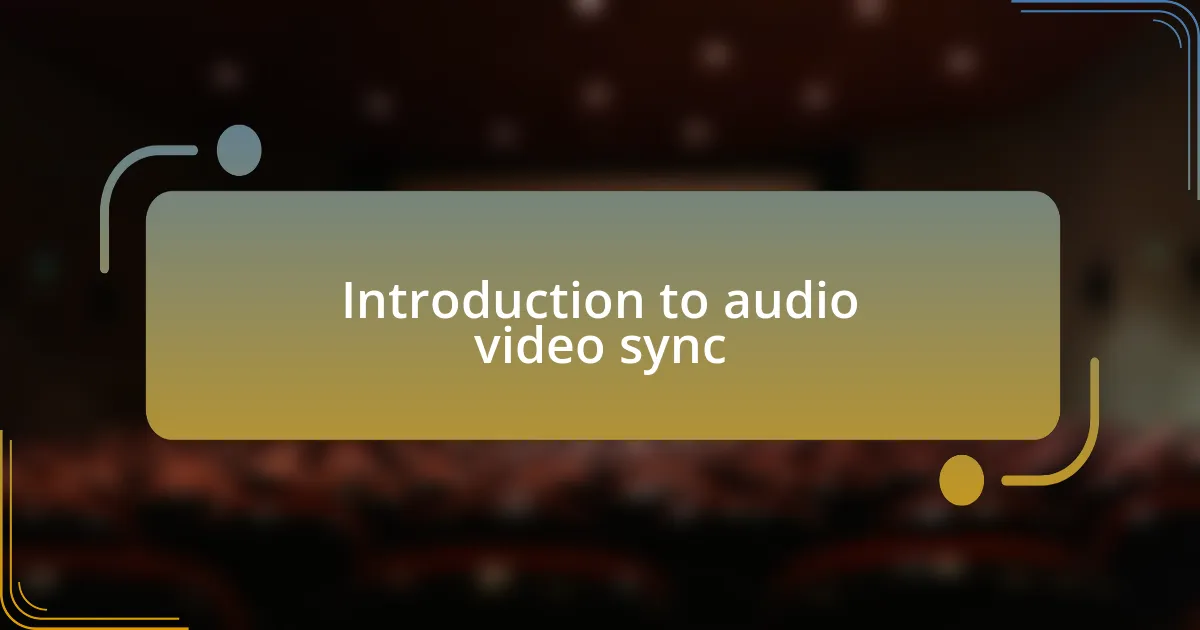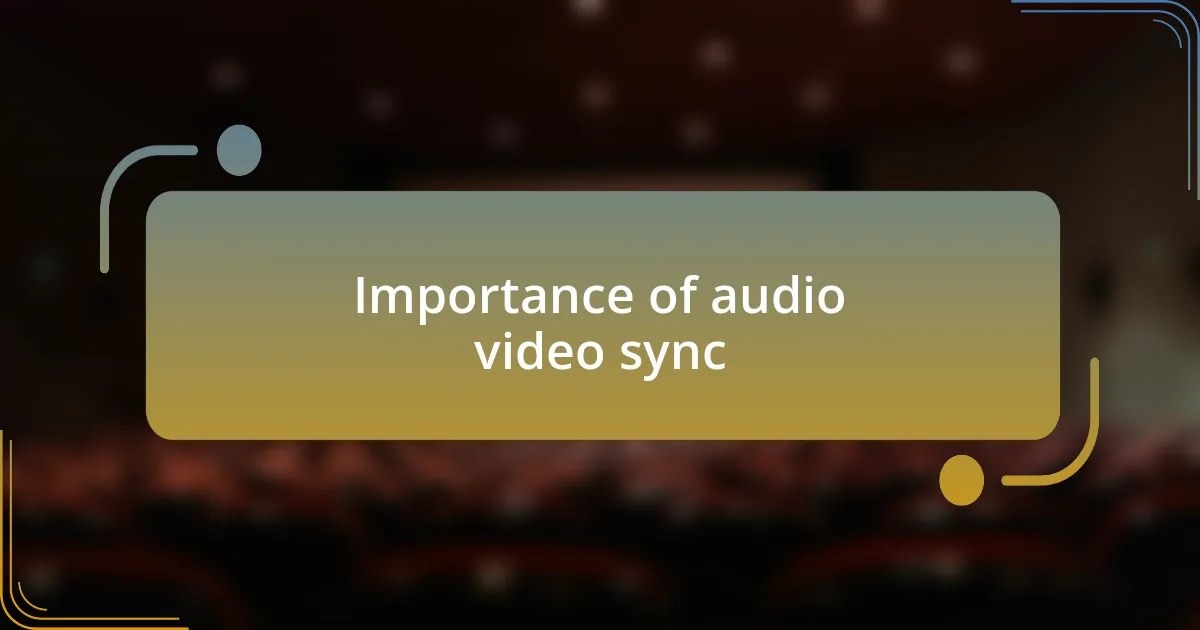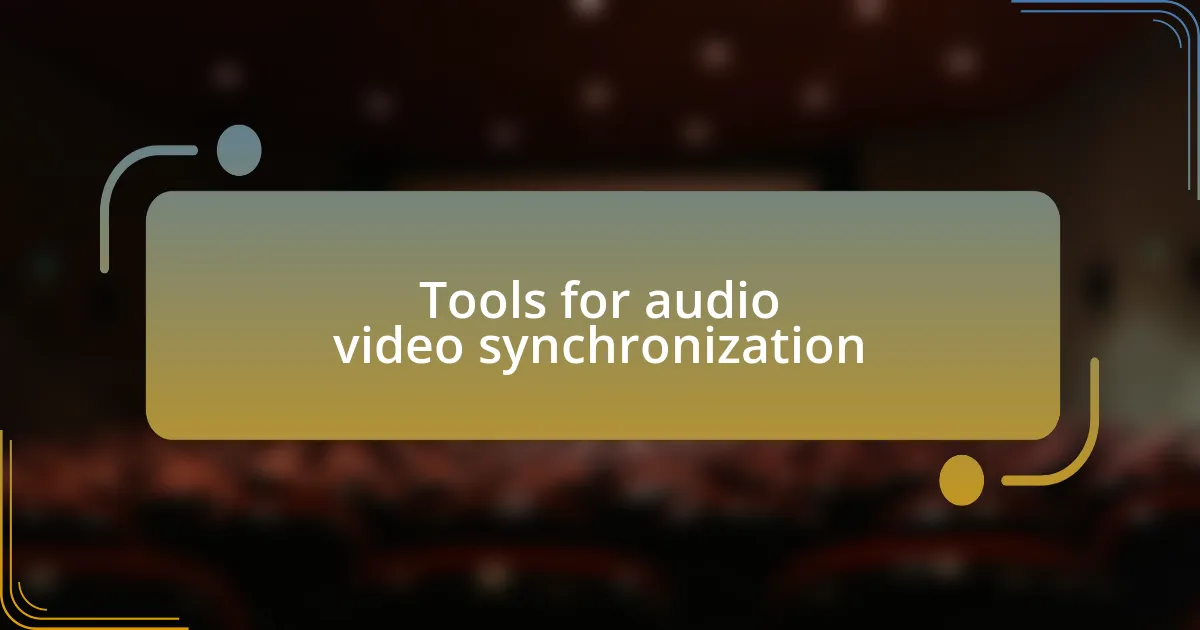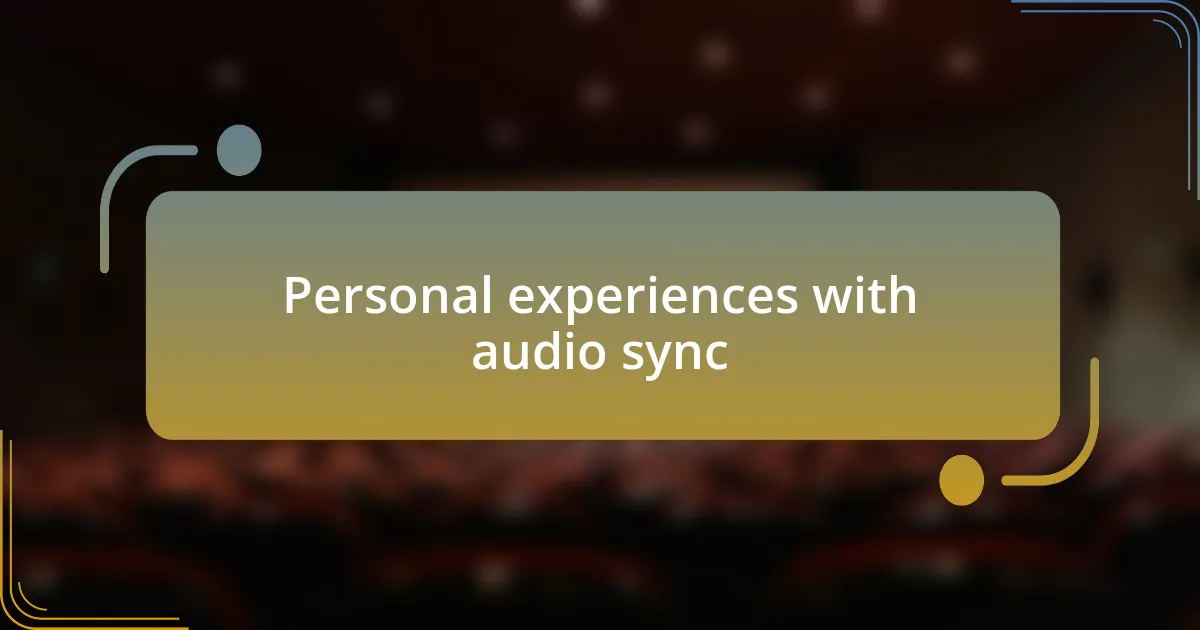Key takeaways:
- Audio-video sync significantly impacts emotional engagement and viewer immersion in films.
- Common techniques for achieving sync include using visual cues like clapperboards and matching audio waveform patterns.
- Software tools such as Adobe Premiere Pro and PluralEyes streamline the syncing process, enhancing efficiency and workflow.
- Personal experiences highlight the importance of precise syncing, as even minor errors can disrupt the emotional impact of a scene.

Introduction to audio video sync
Audio-video sync is a crucial aspect of filmmaking that often goes unnoticed by the audience, but its impact is profound. Imagine watching a scene where the actor’s lips move, but the words come through a split second later. It’s jarring, isn’t it? This experience can rip viewers out of the moment and diminish emotional engagement.
In my early days as a filmmaker, I remember the frustration of grappling with sync issues during post-production. Hours spent tweaking audio levels to match the video felt tedious, yet that effort was essential. Each adjustment brought me closer to a polished final cut that truly resonated with the audience. It’s fascinating how a well-synced audio track can elevate a scene, adding depth to the actors’ performances and creating a seamless viewing experience.
Understanding audio-video sync is like learning a new language; it’s not just about technical skills, but also about conveying emotion and intent. Have you ever felt the weight of a moment fall flat due to a sync error? The right sound elevates visuals and, in many cases, can make or break a film scene. In my experience, mastering this element of production is not only satisfying, but it’s also pivotal to creating a compelling story.

Importance of audio video sync
When I first delved into the world of sound design, I quickly learned that audio-video sync isn’t just a logistical concern; it’s the heartbeat of a film. Picture a gripping dialogue scene, where every carefully crafted word is met with the right facial expression at just the right moment. If the sync falters, that captivating dialogue can lose its weight, and viewers may find themselves distracted instead of entranced.
I recall a particular short film project where we faced significant sync challenges during editing. I distinctly remember the moment when we finally got it right—the relief was palpable. Suddenly, the actors’ performances seemed more authentic, and the emotional arcs felt complete. It struck me then: achieving perfect sync is fundamental to immersing the audience in the story.
Have you ever felt the tension in a horror movie snap because the scream didn’t match the action on screen? In my view, audio and visual coherence is essential for creating the desired atmosphere. The impact of seamless sync goes beyond technical perfection; it plays a pivotal role in establishing mood, enhancing audience engagement, and ensuring that narrations resonate deeply.

Common techniques for syncing
When it comes to syncing audio and video, I’ve noticed that one of the most effective techniques involves using visual cues, like clapperboards. I remember working on a documentary where we relied heavily on these cues. Seeing that clapperboard close just before a scene not only provided a visual reference but also created a clear audio spike that made syncing much simpler. It’s like having a friendly guide in the editing room, ensuring that everything falls into place smoothly.
Another common method that I’ve found invaluable is matching the waveform patterns of the audio tracks. The first time I discovered this technique during a music video project, it felt almost like solving a puzzle. Aligning the peaks and troughs of the audio waveform with the corresponding actions on-screen brought a satisfying sense of accomplishment. Have you ever experienced that rush when everything just clicks? There’s something incredibly rewarding about watching a scene transform as the sound aligns perfectly, making the moments come to life in a way that feels genuine.
Lastly, I can’t stress enough the importance of using software tools designed for this exact purpose. During one editing marathon, I was introduced to timecode syncing, and it felt like a game changer. By using software that allows you to adjust the audio timing based on real-time video playback, I was able to achieve precise synchronization in a fraction of the time. It made the whole process not only more efficient but also more enjoyable. Have you ever worked with tools that streamlined your workflow like that? It’s moments like these that reaffirm my belief in the power of technology to elevate the art of filmmaking.

Tools for audio video synchronization
When I dive into audio-video synchronization, there are several tools that have truly enhanced my workflow. One standout is Adobe Premiere Pro. I remember my first project in Premiere; it felt magical to see how its audio syncing feature automatically matched clips based on audio patterns. I couldn’t believe how much time I saved—have you ever had a project where the hours just melted away because the right tool made everything easier?
Another tool I’ve been exploring is PluralEyes by Red Giant. This software is a real lifesaver for projects with multiple cameras and audio sources. The first time I used it, I was blown away by how quickly it analyzed all the audio tracks and synced them flawlessly. It’s like a superpower for editors, allowing me to focus on storytelling rather than getting bogged down in technicalities. Have you ever found a tool that completely transformed how you approach your projects?
For those working on mobile edits, there are apps like Filmic Pro that offer impressive audio sync capabilities. I recall using it during a shoot on location; having the ability to record high-quality audio and automatically sync it in post was incredible. It allowed me to capture those spontaneous moments without worrying about later syncing chaos. Isn’t it amazing how far technology has come to support our creative endeavors?

Personal experiences with audio sync
When I think about syncing audio with video, a particularly challenging moment stands out. During a short film project, we missed a crucial moment because the audio lagged just enough to throw off the entire scene’s impact. I felt frustrated, realizing that a small sync issue could derail the emotional delivery we worked hard to achieve. Have you ever experienced a moment where everything seemed perfect until that one detail became a glaring problem?
Another memorable experience happened while working on a documentary. I remember the day we captured an interview; the sound was pristine, but matching it to the video was more like a puzzle. I found myself leaning closer to the screen, adjusting the audio waveforms while wondering if this was truly worth the headache. But once it was set, seeing the final cut flow seamlessly felt incredibly rewarding. It made me appreciate the fine line between chaos and harmony in our craft.
In a lighter moment, I decided to experiment with a music video project one weekend. I recorded some live performances, but due to a technical glitch, the audio came out slightly out of sync. Rather than panic, I saw it as a creative challenge. Fixing the sync not only sharpened my skills but also got my creative juices flowing. Have you ever had a mishap turn into a valuable learning experience? It’s in those moments that I find my passion for editing truly ignites.